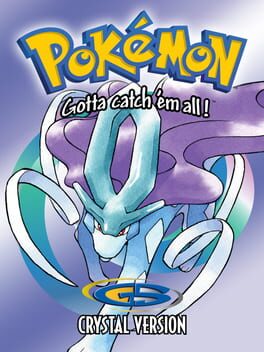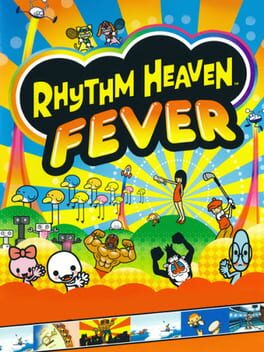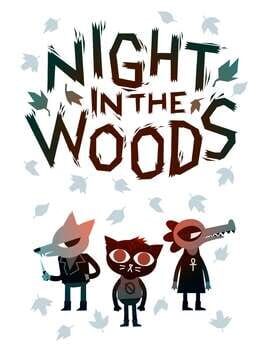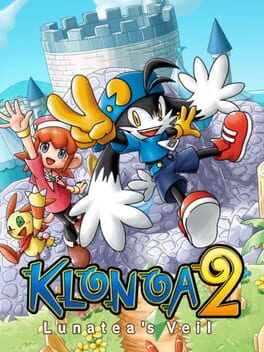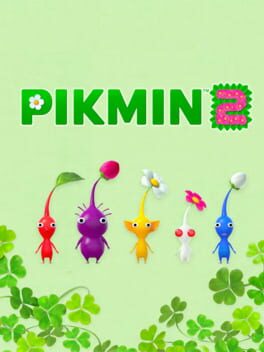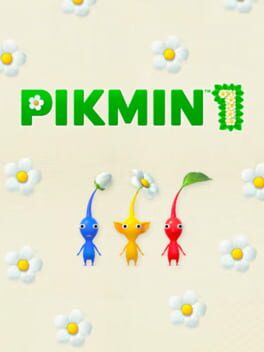Bio
Nothing here!
Badges

Organized
Created a list folder with 5+ lists

GOTY '23
Participated in the 2023 Game of the Year Event

1 Years of Service
Being part of the Backloggd community for 1 year

Shreked
Found the secret ogre page

Roadtrip
Voted for at least 3 features on the roadmap

GOTY '22
Participated in the 2022 Game of the Year Event

Elite Gamer
Played 500+ games

Gamer
Played 250+ games

N00b
Played 100+ games
Favorite Games
606
Total Games Played
015
Played in 2024
177
Games Backloggd
Recently Played See More
Recently Reviewed See More
There’s a lot that could be said in regard to what makes a good remake of older media. What does it add to the original? How does it improve upon what was already there? Are things shaken up? Super Mario RPG was an interesting remake for me. It’s a game that took me a little over 15 hours to finish the main story, but one that took me a month and a half to get through. It was one of the first remakes I’ve played where the questions I asked earlier felt important to ask.
Super Mario RPG for Switch is a game clearly made with love for its source material. The graphical style is a love letter to the original sprite art, and the music reimagined by original composer Yoko Shimomura is an incredible treat to the ears. But at the end of the day, I feel like I can’t say that it isn’t a good game for any other reason than Super Mario RPG for Super Nintendo was. As refreshing as it is to see a new Mario game have the same weirdness of the original, it feels like a punched up version whose additions such as Triple Moves, or the ability to switch around your party mid-battle only make an easy game even easier. The new post-game battles were some of the most fun I had with the new release, but I don’t really feel they did much to justify the new release. A few holdovers from the originals feel weird in a modern release as well. A lack of sound effect for advancing text boxes translates as a minor lack of polish, for example, or how the new, beautiful cutscenes for meeting new characters, often have spoken dialogue alongside a silent, pantomiming character. I can imagine those who don’t know this is a remake finding some of these quirks of the original off-putting, or oddly removed from the modern space.
The two big comparisons that fit to pair with Super Mario RPG are from the 2019 release of The Legend of Zelda: Link’s Awakening and the 2021 release of Pokémon Brilliant Diamond and Shining Pearl. Link’s Awakening was mostly loved by those who played it. It was a refreshing update to the original Game Boy release. It took issues that the original game had and fixed them, and gave it an adorable art style that, while reminiscent of the original Game Boy art, was still very much its own coherent take on the world of Koholint Island. Brilliant Diamond and Shining Pearl, on the other hand were received pretty poorly for how they adapted the original games. The art style felt soulless, a corporate reimagining of the original sprites. The game itself wasn’t updated in any meaningful way. Not only did I feel my time would be better spent with the original Diamond and Pearl release, there was already a rerelease in Pokémon Platinum that was still a much more full experience than the Switch games.
Super Mario RPG stands significantly closer to Link’s Awakening in this regard, but I can’t help but still want to have played the original game again instead. While I love the visuals and music, the game on the whole doesn’t feel or add much significance beyond the original Super Nintendo game. The extras are nice, but they feel closer to back-of-the-box features than ways to improve the experience on the whole. Super Mario RPG on Super Nintendo didn’t have any issues holding it back the same way that Link’s Awakening did on Game Boy. I’m happy to see Mallow and Geno in the spotlight. I’m happy that more people are likely playing this than they would a release of the original on Nintendo Switch Online. I’m happy that this was made with as much love and care as it was. I’m happy this game exists! I can’t shake the feeling that it doesn’t overtake the original though - it didn’t take me a month and a half to play because it was long, or because I didn’t have time; It took me a month and a half because it didn’t really pull me in. The next time I play Super Mario RPG, it likely won’t be the 2023 release - not for a lack of quality or love for the game, but for how it the original still feels like what Super Mario RPG is meant to be.
Super Mario RPG for Switch is a game clearly made with love for its source material. The graphical style is a love letter to the original sprite art, and the music reimagined by original composer Yoko Shimomura is an incredible treat to the ears. But at the end of the day, I feel like I can’t say that it isn’t a good game for any other reason than Super Mario RPG for Super Nintendo was. As refreshing as it is to see a new Mario game have the same weirdness of the original, it feels like a punched up version whose additions such as Triple Moves, or the ability to switch around your party mid-battle only make an easy game even easier. The new post-game battles were some of the most fun I had with the new release, but I don’t really feel they did much to justify the new release. A few holdovers from the originals feel weird in a modern release as well. A lack of sound effect for advancing text boxes translates as a minor lack of polish, for example, or how the new, beautiful cutscenes for meeting new characters, often have spoken dialogue alongside a silent, pantomiming character. I can imagine those who don’t know this is a remake finding some of these quirks of the original off-putting, or oddly removed from the modern space.
The two big comparisons that fit to pair with Super Mario RPG are from the 2019 release of The Legend of Zelda: Link’s Awakening and the 2021 release of Pokémon Brilliant Diamond and Shining Pearl. Link’s Awakening was mostly loved by those who played it. It was a refreshing update to the original Game Boy release. It took issues that the original game had and fixed them, and gave it an adorable art style that, while reminiscent of the original Game Boy art, was still very much its own coherent take on the world of Koholint Island. Brilliant Diamond and Shining Pearl, on the other hand were received pretty poorly for how they adapted the original games. The art style felt soulless, a corporate reimagining of the original sprites. The game itself wasn’t updated in any meaningful way. Not only did I feel my time would be better spent with the original Diamond and Pearl release, there was already a rerelease in Pokémon Platinum that was still a much more full experience than the Switch games.
Super Mario RPG stands significantly closer to Link’s Awakening in this regard, but I can’t help but still want to have played the original game again instead. While I love the visuals and music, the game on the whole doesn’t feel or add much significance beyond the original Super Nintendo game. The extras are nice, but they feel closer to back-of-the-box features than ways to improve the experience on the whole. Super Mario RPG on Super Nintendo didn’t have any issues holding it back the same way that Link’s Awakening did on Game Boy. I’m happy to see Mallow and Geno in the spotlight. I’m happy that more people are likely playing this than they would a release of the original on Nintendo Switch Online. I’m happy that this was made with as much love and care as it was. I’m happy this game exists! I can’t shake the feeling that it doesn’t overtake the original though - it didn’t take me a month and a half to play because it was long, or because I didn’t have time; It took me a month and a half because it didn’t really pull me in. The next time I play Super Mario RPG, it likely won’t be the 2023 release - not for a lack of quality or love for the game, but for how it the original still feels like what Super Mario RPG is meant to be.
My first revisit of Pikmin in a very long time - my first since playing every other game in the franchise - was one I wasn’t too sure of its outcome before starting. Not only was it my first time not using the Wii’s pointer controls, but Pikmin is a series that has grown much since its original conception. The first was a little clunky even back in the day, so how would it hold up today compared to its more refined follow-ups?
I’m happy to say that it held up exceptionally well. From starting the game again, I was once again enamored by the tone and mystique the first game offers its otherworldly crash landing. I mostly played wearing headphones, and it was my first time hearing much of this music directly into my ears. While later games leaned more on the quirky, adorable nature of the Pikmin, the first game offers something unsettling - a survival story of Captain Olimar trying to recover parts of his ship before his supply of breathable air has gone dry. What was once such a defining tone of the game would later become something entirely different, and while both directions are fitting for the series, there is something special about the first game’s presentation.
The original Pikmin’s gameplay is something that also holds up excellently. While it could stand to have many of the improvements found in later games, such as a lock-on mechanic or more variety amongst the included types of Pikmin to use, the simplicity of the first game is not to disregard. It’s a loop that’s still captivating; you’re exploring three major areas and two smaller ones trying to find all of the missing components of your ship. They can be anywhere: out in the open, behind an obstacle, or even in the belly of a giant beast. To get these parts, you’ll need to order your Pikmin to build bridges, tear down walls, and bring down foes big and small. The puzzle elements of the series isn’t at it’s strongest here (I found that to be a highlight of Pikmin 3 in particular), but it is far from absent. The three original types of Pikmin may not be the most useful past the required water-immunity of blues or high throwing arcs of yellows, but the high damage output of red Pikmin make them the MVP of the first game. You have 30 days to get 30 ship parts… can you do it?
If there’s any point where the first Pikmin game falters, it’s the little things. Pikmin aren’t the smartest creatures. Even matured flower Pikmin trip often and fall behind, and they will follow you to the best of their ability. Unfortunately their best is often falling off of a slope or getting stuck on a wall. While I didn’t experience it here, I don’t want to say with confidence that the Switch port off the game fixed glitches such as Pikmin dying under a bridge. Absolutely a limitation of the time, without a doubt, but I found on revisiting this game that their lackluster ability to follow you correctly is often used by the developers to make the player consider bringing a smaller group, or to prevent a larger group from entering. Power in numbers be damned, sometimes bringing a smaller posse of Pikmin to battle can be a smarter decision! The player being able to go places your Pikmin can’t always go is something the first game’s level design excels at.
Pikmin is an excellent game, even today. It excels at what it aims to do, even if what future games expanded upon improved the formula in more ways than one. In some regards, such as tone and mechanical balance, the original game even outshines its successors. The Switch port of the game is notably bare, unfortunately. This isn’t the same treatment that Metroid Prime got. What we have is a much cleaner presentation of the Wii version of the game, without the Wii version’s excellent controls. Pikmin 3 Deluxe on Switch received tweaks to its mechanics to mechanics to fit the lack of control options. While I adapted quickly to the control stick option, it did take some time compared to how long it took me to adapt to the Wii version, and less options are never ideal. In the end, what we have is the GameCube version’s controls in the Wii version of the game, stretched UI assets and all. While I value the accessibility of the game more than the idea of a more impactful remaster, I can’t help but wish for a bigger update. On the other hand, they DID redo the entire enemy roll at the end of the game! That was a nice surprise. They’ll always be wollywogs to me.
I’m happy to say that it held up exceptionally well. From starting the game again, I was once again enamored by the tone and mystique the first game offers its otherworldly crash landing. I mostly played wearing headphones, and it was my first time hearing much of this music directly into my ears. While later games leaned more on the quirky, adorable nature of the Pikmin, the first game offers something unsettling - a survival story of Captain Olimar trying to recover parts of his ship before his supply of breathable air has gone dry. What was once such a defining tone of the game would later become something entirely different, and while both directions are fitting for the series, there is something special about the first game’s presentation.
The original Pikmin’s gameplay is something that also holds up excellently. While it could stand to have many of the improvements found in later games, such as a lock-on mechanic or more variety amongst the included types of Pikmin to use, the simplicity of the first game is not to disregard. It’s a loop that’s still captivating; you’re exploring three major areas and two smaller ones trying to find all of the missing components of your ship. They can be anywhere: out in the open, behind an obstacle, or even in the belly of a giant beast. To get these parts, you’ll need to order your Pikmin to build bridges, tear down walls, and bring down foes big and small. The puzzle elements of the series isn’t at it’s strongest here (I found that to be a highlight of Pikmin 3 in particular), but it is far from absent. The three original types of Pikmin may not be the most useful past the required water-immunity of blues or high throwing arcs of yellows, but the high damage output of red Pikmin make them the MVP of the first game. You have 30 days to get 30 ship parts… can you do it?
If there’s any point where the first Pikmin game falters, it’s the little things. Pikmin aren’t the smartest creatures. Even matured flower Pikmin trip often and fall behind, and they will follow you to the best of their ability. Unfortunately their best is often falling off of a slope or getting stuck on a wall. While I didn’t experience it here, I don’t want to say with confidence that the Switch port off the game fixed glitches such as Pikmin dying under a bridge. Absolutely a limitation of the time, without a doubt, but I found on revisiting this game that their lackluster ability to follow you correctly is often used by the developers to make the player consider bringing a smaller group, or to prevent a larger group from entering. Power in numbers be damned, sometimes bringing a smaller posse of Pikmin to battle can be a smarter decision! The player being able to go places your Pikmin can’t always go is something the first game’s level design excels at.
Pikmin is an excellent game, even today. It excels at what it aims to do, even if what future games expanded upon improved the formula in more ways than one. In some regards, such as tone and mechanical balance, the original game even outshines its successors. The Switch port of the game is notably bare, unfortunately. This isn’t the same treatment that Metroid Prime got. What we have is a much cleaner presentation of the Wii version of the game, without the Wii version’s excellent controls. Pikmin 3 Deluxe on Switch received tweaks to its mechanics to mechanics to fit the lack of control options. While I adapted quickly to the control stick option, it did take some time compared to how long it took me to adapt to the Wii version, and less options are never ideal. In the end, what we have is the GameCube version’s controls in the Wii version of the game, stretched UI assets and all. While I value the accessibility of the game more than the idea of a more impactful remaster, I can’t help but wish for a bigger update. On the other hand, they DID redo the entire enemy roll at the end of the game! That was a nice surprise. They’ll always be wollywogs to me.
Pikmin 4 was a game long-time coming, and in so many ways it delivers on that wait. It takes so many moves to evolve the formula and move it forward, while taking what the series has already done and try to streamline it. Much of its execution is superb, but in other places it falters just enough to hold it back from being the best in the series.
Of all things the game does right, the absolutely gorgeous environments are a standout. The series has always been bringing the player to see everyday objects and nature up close at a quarter-sized viewpoint, and never has it looked this beautiful. The new, more player-controllable camera does an excellent job of bringing what was once a more top-down perspective right down to eye level. You can see incredible, mountainous dirt mounds, leaves, and even human-made structures like a bench or outdoor grill in the distance. It's always jaw-dropping, and it's commendable that they were able to make this game look so good with such realistic environments.
Pikmin 4 attempts to mix-up how the player goes about their many days of treasure hunting and castaway-saving from previous entries. The two major changes are that players are limited to three types of Pikmin at a time, and that they must work their way up to the once-default 100 Pikmin limit in the field. Both of these ideas are great, and changes how familiar players will go about their exploration. Having a smaller party means that each encounter cannot be cleared out with the 100-man powerhouse that they could in the past. It also gives the player more ways to grow and develop as the game goes on, something that the Tech Lab and its various upgrades also do incredibly well.
While the 3 Pikmin type limit enticed me during the start, I quickly found it a bit boring of a limit. It's a great way to have the player focus on what a particular area might need to best go through, and I don't believe Nintendo would have otherwise brought back (nearly) all previous Pikmin types for the main campaign. Where this falls flat for me is that every area tells the player from the start what is best for that area, and it rarely asks for more than those three types. What could've been an entire layer of strategy and discovery just turns into taking out the Pikmin the game tells you to. The same goes with the returning caves, which I also found much more simple and less satisfying than their counterparts in Pikmin 2. Nonetheless I was happy for their return.
This leads to what I found to be an incredible addition to the game, but one I found left me conflicted by the end -- the Rescue Corps rescue pup Oatchi. Oatchi acts as somewhat of combination of a second captain for multi-tasking, and a Pikmin himself. It's a great idea, that simplifies and evolves the multi-captain approach of the past. Giving commands to Oatchi is simple, and Oatchi helps the player in many many ways. However, in someways, Oatchi is a little too good. I found the final cave disappointing, with many would-be-challenging fights simplified by having all of my Pikmin latch onto Oatchi's back, or an army of Purple Pikmin being able to take down an enemy over water because they can hop right back onto the safety of Oatchi's back. I think Oatchi's possibilities are incredible, and make the player feel powerful, but I think the game shouldn't have been afraid to take Oatchi away from the player from time to time, and ask them to take on challenges without his help.
Pikmin 4 is a bigger game than all of the previous entries. With a whopping 30+ hours of treasure hunting, I was admittedly a little fatigued by the end. It didn't help that this was a much, much easier game than previous entries. Oatchi was an excellent, but overpowered addition to the formula. I love the quality of life changes like the ability to rewind a few minutes at a time and the (sometimes frustrating) auto-lock on - I'm very happy that this is seemingly a much more accessible game for new players. The ways that the gameplay has evolved are excellent as well. This was very close to being right up there with Pikmin 3, and even Pikmin 2 for my favorite, but a somewhat long runtime and a noticeable lack of challenge holds an otherwise exceptional game back. Despite my nitpicking, you cannot go wrong with Pikmin 4. There is an incredibly good time to be had with this one.
Of all things the game does right, the absolutely gorgeous environments are a standout. The series has always been bringing the player to see everyday objects and nature up close at a quarter-sized viewpoint, and never has it looked this beautiful. The new, more player-controllable camera does an excellent job of bringing what was once a more top-down perspective right down to eye level. You can see incredible, mountainous dirt mounds, leaves, and even human-made structures like a bench or outdoor grill in the distance. It's always jaw-dropping, and it's commendable that they were able to make this game look so good with such realistic environments.
Pikmin 4 attempts to mix-up how the player goes about their many days of treasure hunting and castaway-saving from previous entries. The two major changes are that players are limited to three types of Pikmin at a time, and that they must work their way up to the once-default 100 Pikmin limit in the field. Both of these ideas are great, and changes how familiar players will go about their exploration. Having a smaller party means that each encounter cannot be cleared out with the 100-man powerhouse that they could in the past. It also gives the player more ways to grow and develop as the game goes on, something that the Tech Lab and its various upgrades also do incredibly well.
While the 3 Pikmin type limit enticed me during the start, I quickly found it a bit boring of a limit. It's a great way to have the player focus on what a particular area might need to best go through, and I don't believe Nintendo would have otherwise brought back (nearly) all previous Pikmin types for the main campaign. Where this falls flat for me is that every area tells the player from the start what is best for that area, and it rarely asks for more than those three types. What could've been an entire layer of strategy and discovery just turns into taking out the Pikmin the game tells you to. The same goes with the returning caves, which I also found much more simple and less satisfying than their counterparts in Pikmin 2. Nonetheless I was happy for their return.
This leads to what I found to be an incredible addition to the game, but one I found left me conflicted by the end -- the Rescue Corps rescue pup Oatchi. Oatchi acts as somewhat of combination of a second captain for multi-tasking, and a Pikmin himself. It's a great idea, that simplifies and evolves the multi-captain approach of the past. Giving commands to Oatchi is simple, and Oatchi helps the player in many many ways. However, in someways, Oatchi is a little too good. I found the final cave disappointing, with many would-be-challenging fights simplified by having all of my Pikmin latch onto Oatchi's back, or an army of Purple Pikmin being able to take down an enemy over water because they can hop right back onto the safety of Oatchi's back. I think Oatchi's possibilities are incredible, and make the player feel powerful, but I think the game shouldn't have been afraid to take Oatchi away from the player from time to time, and ask them to take on challenges without his help.
Pikmin 4 is a bigger game than all of the previous entries. With a whopping 30+ hours of treasure hunting, I was admittedly a little fatigued by the end. It didn't help that this was a much, much easier game than previous entries. Oatchi was an excellent, but overpowered addition to the formula. I love the quality of life changes like the ability to rewind a few minutes at a time and the (sometimes frustrating) auto-lock on - I'm very happy that this is seemingly a much more accessible game for new players. The ways that the gameplay has evolved are excellent as well. This was very close to being right up there with Pikmin 3, and even Pikmin 2 for my favorite, but a somewhat long runtime and a noticeable lack of challenge holds an otherwise exceptional game back. Despite my nitpicking, you cannot go wrong with Pikmin 4. There is an incredibly good time to be had with this one.

